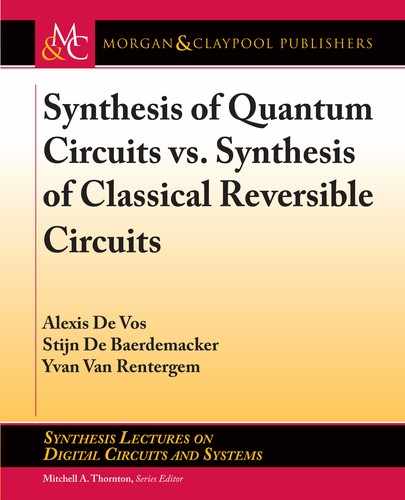86 5. TOP-DOWN
decomposition
0
B
B
B
B
B
B
B
B
B
B
B
@
0 0 0 1
1 0 0 0
0 1 0 0
0 0 1 0
1 0 0 0
0 0 0 1
0 0 1 0
0 1 0 0
1
C
C
C
C
C
C
C
C
C
C
C
A
0
B
B
B
B
B
B
B
B
B
B
B
@
0 1
0 1
0 1
1 0
1 0
1 0
1 0
0
1
1
C
C
C
C
C
C
C
C
C
C
C
A
0
B
B
B
B
B
B
B
B
B
B
B
@
1 0 0 0
0 1 0 0
0 0 1 0
0 0 0 1
0 0 0 1
0 0 1 0
0 1 0 0
1 0 0 0
1
C
C
C
C
C
C
C
C
C
C
C
A
:
5.4 GROUP HIERARCHY
As mentioned in Section 4.3, there are 1
n
2
=4
matrices in bXU(n). We investigate which of
these bXU matrices are permutation matrices. For a matrix of form (4.6) to be a permutation
matrix, the unitary matrix C is not allowed to have any non-zero elements outside its diagonal.
Indeed, if C
jk
¤ 0 with j ¤ k, then the j th row of (4.6) would have four non-zero elements, a
property not allowed for permutation matrices. e diagonal elements C
jj
have to equal either 1
or 1. Otherwise, the j th row of (4.6) would have two non-zero elements. Hence, the unitary
matrix C has to be an n=2 n=2 diagonal matrix with exclusively ˙1 entries. ere exist only
2
n=2
such matrices.
We now investigate which of the bZU matrices are permutation matrices. For a matrix of
form (4.7) to be a permutation matrix, the unitary matrix D has to be an n=2 n=2 permutation
matrix. ere exist .n=2/Š such matrices.
We conclude: whereas
• all nŠ elements of P(n) are inside the group XU(n) and
• only one element of P(n), i.e., the n n unit matrix, is inside ZU(n),
there are
• only 2
n=2
elements of P(n) inside bXU(n) and
• .n=2/Š elements of P(n) inside bZU(n),
• the remaining nŠ 2
n=2
.n=2/Š C 1 elements being neither in bXU(n) nor in bZU(n).
For example, the following P(4) matrices
0
B
B
@
1
1
1
1
1
C
C
A
;
0
B
B
@
1
1
1
1
1
C
C
A
; and
0
B
B
@
1
1
1
1
1
C
C
A
;
respectively, belong

5.4. GROUP HIERARCHY 87
• to bXU(4) with C D
1 0
0 1
,
• to bZU(4) with D D
0 1
1 0
, and
• to neither of them.
All three belong to XU(4); see Figures 5.1 and 5.2.
XU(?)
U(?)
P(?)
ZU(?)
Figure 5.1: Venn diagram of the Lie groups U(n), XU(n), and ZU(n) and the finite groups P(n)
and
1
(
n
).
Note: the trivial group 1(n) is represented by the bullet.
bXU(?)
U(?)
P(?)
bZU(?)
Figure 5.2: Venn diagram of the Lie groups U(n), bXU(n), and bZU(n) and the finite groups
P(n) and 1(n).
Note: the trivial group 1(n) is represented by the bullet.
e intersection of the groups P(n) and bXU(n) is the group denoted P
x
(n) in Section 2.2.
It has order 2
n=2
and is isomorphic to the direct product S
n=2
2
. A block XU(n) matrix can only
be a permutation matrix provided C is a diagonal n=2 n=2 matrix with all n=2 diagonal en-
tries equal to ˙1. e corresponding n n matrices
I
C
can be interpreted as being built

88 5. TOP-DOWN
from n=2 blocks of size 2 2 and of type
1
˙1
. erefore, if n D 2
w
, such matrices rep-
resent multiply controlled Z gates acting on the first qubit. us the corresponding products
G
I
C
G satisfy the equality
H Z H X
D
D
:
Analogously, the intersection of the groups Q(n), defined in Section 3.8, and bZU(n) is
a group which we will denote Q
z
(n). It consists of all n n diagonal matrices with exclusively
entries 1 in the upper half diagonal and ˙1 in the lower half diagonal. It has order 2
n=2
and is
isomorphic to the direct product S
n=2
2
; see Figure 5.3.
S(?)
U(?)
P
x
(?)
bXU(?)
Q
z
(?)
bZU(?)
1(?)
Figure 5.3: Hierarchy of the Lie groups U(n), bXU(n), and bZU(n) and the finite groups S(n),
P
x
(n), Q
z
(n), and 1(n).
Although Figures 3.3 and 5.3 resemble each other, there is an important quantitative dif-
ference. Whereas in Figure 3.3 the groups XU(n) and ZU(n) have quite different dimensions
(i.e., .n 1/
2
and n 1, respectively), in Figure 5.3 the groups bXU(n) and bZU(n) have the
same dimension, i.e., .n=2/
2
. Whereas in Figure 3.3 the groups P(n) and Q(n) have quite dif-
ferent orders (i.e., nŠ and 2
n1
, respectively), in Figure 5.3 the groups P
x
(n) and Q
z
(n) have the
same order, i.e., 2
n=2
. us, Figure 5.3 has a nice symmetry, absent in Figure 3.3. is symmetry
is also expressed by the fact that bXU(n) and bZU(n) are conjugate and so are P
x
(n) and Q
z
(n):
bXU.n/ D G bZU.n/ G and bZU.n/ D G bXU.n/ G I
..................Content has been hidden....................
You can't read the all page of ebook, please click here login for view all page.
